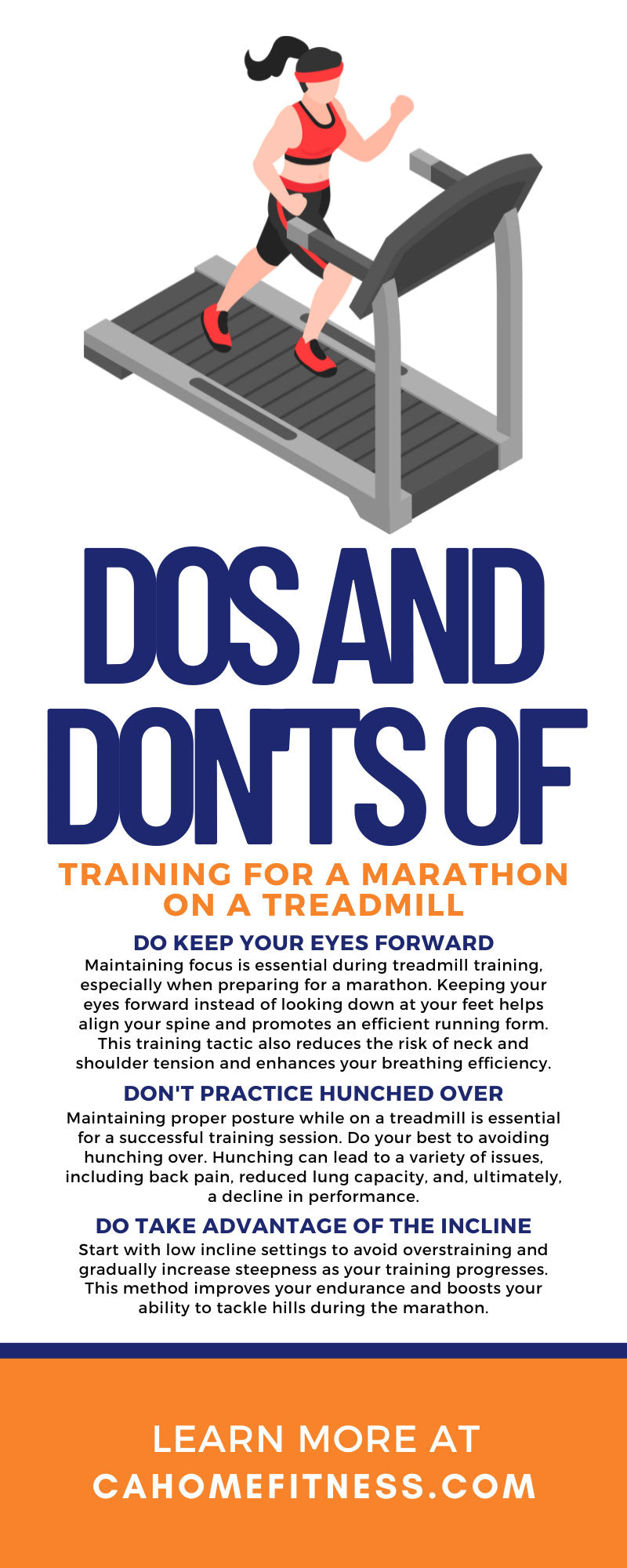No Products in the Cart
As you train for running a marathon, you may find that the conditions outside aren’t always agreeable. That’s where a treadmill can help, providing you with a surface to train, regardless of the weather conditions. However, it’s important to do so carefully in order to make the most of your time on this marvelous piece of equipment. Read below for a guide on the dos and don’ts of training for a marathon on a treadmill.
Utilize treadmill training programs for versatility that mimics outdoor terrain. Try settings that involve inclines and varied speeds to simulate different race-day conditions. Additionally, speed variations can help prevent injuries by engaging different muscle groups.
One of the most important don’ts of training for a marathon on a treadmill is setting unrealistic goals. Unachievable goals can set you up for disappointment and result in unnecessary stress and potential injuries. Avoid making drastic jumps in mileage or speed, as these can be harmful and counterproductive.
Instead, create feasible goals that align with your current level of fitness. Focus on incremental improvements that align with your body's ability to adapt and recover. This approach ensures steady progress and keeps motivation high throughout your training journey.
Just as you would hydrate while training outdoors, you should do the same indoors. Ensure you have easy access to water during your treadmill sessions and make a habit of hydrating regularly throughout the day.
Proper hydration supports overall performance, aids in recovery, and helps prevent heat-related issues, allowing you to maintain the intensity and quality of your training sessions. Just make sure you stick to drinks that encourage proper hydration. Hydrate with water or an electrolyte drink instead of things like soda and energy drinks, which can delay your progress and be harmful to your health.
Skipping a warm-up before a treadmill session, especially when training for a marathon, can increase your risk of injuries and reduce your workout efficiency. Prep your body for effective marathon training on a treadmill by starting with a five-minute light jog or brisk walk, gradually ramping up the intensity.
This not only helps to prevent muscle strains but also mentally prepares you for the long run ahead, so that you will see your exercise through to the very end.
Maintaining focus is essential during treadmill training, especially when preparing for a marathon. Keeping your eyes forward instead of looking down at your feet helps align your spine and promotes an efficient running form. This training tactic also reduces the risk of neck and shoulder tension and enhances your breathing efficiency.
Additionally, looking ahead can improve your psychological endurance by fostering a positive mindset and maintaining concentration over long distances. To simulate outdoor running conditions more accurately and prevent the monotony often associated with treadmill workouts, try placing a visual target in front of you or use visualization techniques, such as picturing yourself on race day, to stay motivated and engaged.
Maintaining proper posture while on a treadmill is essential for a successful training session. Do your best to avoiding hunching over. Hunching can lead to a variety of issues, including back pain, reduced lung capacity, and, ultimately, a decline in performance. Bad posture might come about when you’re tired or trying to interact with controls on the treadmill, but maintaining an upright position with shoulders back and down will greatly improve your form.
Good posture prevents injury and facilitates better oxygen flow, making your training sessions more effective. To counteract the tendency to hunch, periodically check your posture, especially as you tire, and make necessary adjustments to stay aligned.
Leveraging the incline feature on your treadmill is a game-changer for marathon training. It allows you to simulate the varying elevations you'll encounter on race day, providing a more comprehensive training experience.
Start with low incline settings to avoid overstraining and gradually increase steepness as your training progresses. This method improves your endurance and boosts your ability to tackle hills during the marathon. Regularly including incline sessions will prepare you for any elevation changes on the course and contribute to a stronger overall performance.
Wearing the right shoes during treadmill training is as important as it is during outdoor runs, especially when preparing for a marathon. Improper training shoes can lead to injuries that derail your training progress.
It's crucial to select footwear that provides adequate support and cushioning.
Monitoring your heart rate during treadmill marathon training is crucial for ensuring you are training efficiently and not overexerting yourself. Your heart rate provides valuable feedback about your workout intensity and can help you stay within the optimal zones for endurance building. Utilize a heart rate monitor to track your pulse in real-time and adjust your pace or incline to remain within your target heart rate zones.
Neglecting a proper cool down after marathon training sessions on a treadmill can be just as detrimental as skipping the warm-up. A cooling down period gradually lowers your heart rate and helps to reduce lactic acid build-up in the muscles, minimizing post-exercise stiffness and soreness.
Spending five to 10 minutes of low-intensity jogging or walking at a slow pace allows for a smoother transition back into a resting state. Incorporating stretches targeting major muscle groups used during running can further enhance flexibility and aid in recovery. This crucial step helps prevent injuries and prepares your body for the next training session, ensuring effective progress toward your marathon goals.
Knowing what you should and shouldn’t do while training on your treadmill will better prepare you to go the distance in your upcoming marathon. California Home Fitness can help you prepare with a wide range of products, including compact treadmills in Southern California. We sell various award-winning products that will help you bring home your own medal on race day.
